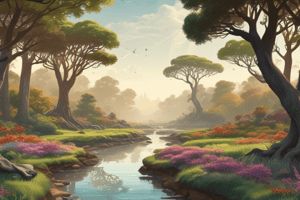Podcast
Questions and Answers
What is the main reason why living things are adapted to their habitats?
What is the main reason why living things are adapted to their habitats?
- To compete with other species
- To survive in their habitats (correct)
- To change their environment
- To adapt to other habitats
What is the purpose of an African elephant's large ears?
What is the purpose of an African elephant's large ears?
- To collect water
- To keep cool (correct)
- To keep warm
- To store food
What is a characteristic of a cactus that helps it survive in the desert?
What is a characteristic of a cactus that helps it survive in the desert?
- A stem that can store cold air
- Thick fur to keep warm
- Shallow roots to collect water from a large area close to the surface (correct)
- Deep roots to collect water from deep underground
What is the result of a mutation in a gene that regulates the cell cycle?
What is the result of a mutation in a gene that regulates the cell cycle?
What is an example of a positive mutation?
What is an example of a positive mutation?
What is the effect of a neutral mutation on an individual?
What is the effect of a neutral mutation on an individual?
What can increase the rate of mutation?
What can increase the rate of mutation?
What is a consequence of a habitat change due to natural disasters or other changes?
What is a consequence of a habitat change due to natural disasters or other changes?
What is the primary focus of Darwin's theory of natural selection?
What is the primary focus of Darwin's theory of natural selection?
What did Darwin conclude about the species of finches on the Galapagos Islands?
What did Darwin conclude about the species of finches on the Galapagos Islands?
What is the result of individuals with successful variations producing more offspring?
What is the result of individuals with successful variations producing more offspring?
What is the title of Darwin's book about his scientific theory of natural selection?
What is the title of Darwin's book about his scientific theory of natural selection?
What is the purpose of the shorter, stouter beaks of some finches?
What is the purpose of the shorter, stouter beaks of some finches?
What is the adaptation of the woodpecker's beak?
What is the adaptation of the woodpecker's beak?
Flashcards are hidden until you start studying
Study Notes
Adaptation for Survival
- Living things are adapted for survival in their habitats through special features or developed better features over time.
- Examples of adaptations include an African elephant's large ears to keep cool in a hot habitat, and a polar bear's thick fur to keep warm in a cold habitat.
- Plants also adapt to their environments, such as a cactus's shallow roots and water-storing stem to survive in the desert.
Mutations
- Mutations are permanent changes in the DNA sequence.
- They can be neutral, positive (advantage), or negative (disadvantage).
- Environmental factors, such as radiation and chemicals, can increase the rate of mutation.
- Examples of mutations include:
- Positive mutation: plants developing resistance to bacterial and fungal infections.
- Negative mutation: cancer, caused by mutations in genes that regulate the cell cycle.
- Neutral mutation: white fur of the Kermode (Spirit) bear, which is usually black.
Theory of Natural Selection
- Evolution is explained by Darwin's basic theory of natural selection.
- The theory focuses on how variations benefit individuals to survive environmental changes, predation, or competition.
- Individuals with successful variations produce more offspring, passing the variation on to the next generation.
- This process allows the population to evolve with the successful variation.
Darwin's Discoveries
- Charles Darwin issued a book about his scientific theory of natural selection called On the Origin of Species in 1859.
- Darwin's theory explained how every living thing is connected in a family tree that stretches back billions of years to the beginning of life on Earth.
- One of Darwin's discoveries was the identification of fourteen different species of Finches in the Galapagos Islands, each with adaptive beaks for their eating habits.
- Examples of adaptive beaks include:
- Strong and sturdy beaks with a chisel-like tip for drilling holes in wood (woodpecker).
- Shorter, stouter beaks for eating seeds found on the ground.
- Long, pointed beaks for picking seeds out of cactus fruits.
Studying That Suits You
Use AI to generate personalized quizzes and flashcards to suit your learning preferences.




